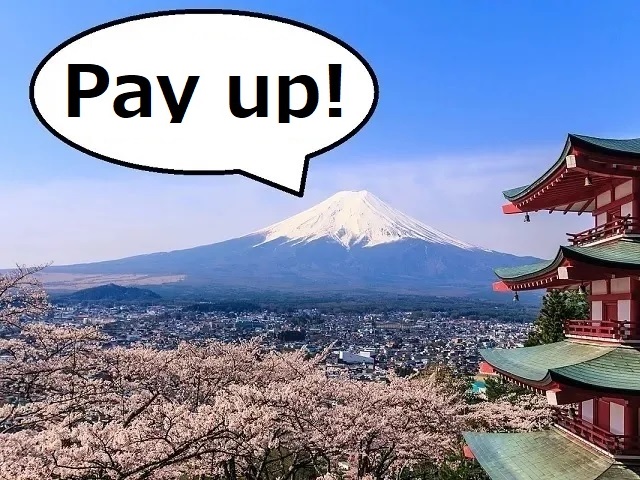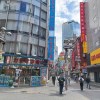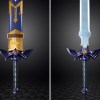
Required fees will be in place by the start of hiking season, and probably won’t be the only thing you’ll need to pay for to see the sunrise from the summit.
Though Mt. Fuji has been one of the most iconic symbols of Japan for generations, the mountain has seen a surging rise in its number of visitors in recent years. Between increased interest in outdoor activities among domestic sightseers and the boom in inbound international travel to Japan, Mt Fuji is a more popular destination than ever, but it’s about to become a more expensive one too.
Earlier this year, the government of Yamanashi, the Prefecture which includes the Yoshida Trail, the most accessible and common route to the top of Mt. Fuji, said it was considering adding a required toll to the trail. on Monday, the prefectural assembly put the idea to a vote, and it was unanimously approved.
Under the new rules, hikers wishing to progress past the Fifth Station on the Yoshida Trail (approximately half-way up the mountain), will have to pay a toll of 2,000 yen (US$13.60). This is a per-person, not per-group, toll. The new ordinance doesn’t start until July 1. However, the upper sections of Mt. Fuji are closed to hiking during the fall, winter, and spring, so essentially the Yoshida Trail toll is already in effect, in the sense that there’s no way to officially hike the affected section before tolls start being collected.
▼ The Yamanashi prefectural assembly, voting on the Mt. Fuji trial toll
To ensure compliance, a gate will be set up at the Fifth Station. This gate will be closed between 4 p.m. and 3 a.m., and while those dusk-to-dawn hours may not comprise a core hiking time on most trails, Mt. Fuji is an exception. Shortly before sunrise is widely considered the ideal time to arrive at the peak of Mt. Fuji, in order to see the breathtaking phenomenon of the morning sun rising through the sea of clouds that regularly circles the summit. To time this, some people hike through the night, passing by the fifth station after sundown, and then hike back home directly from the summit.
The gate closure hours were specifically chosen to prevent this itinerary, which is called dangan tozan, or “bullet climbing.” Passing through the Fifth Station before 4 p.m. and heading straight to the peak will get you there too early to see the sunrise, and passing through at 3 a.m. means you’ll be too late. Instead, the Yamanashi government would like you to spend the night in, and spend money on, lodging in one of the mountain huts on Mt. Fuji between the Fifth Station and the peak so that you can reach the top right as the sun is coming up. Prices for huts vary by location and specific day, but often start at around 5,000 yen per person, and unless you want to stand around for hours on the mountain in the middle of the night, such lodging fees are going to be an unavoidable expense of visiting the peak at sunrise.
Japan’s hiking trails are usually free to use, and with Mt. Fuji being Yamanashi’s best-known tourism attraction, collecting tolls from hikers stands to be a sizable revenue boost for the prefectural government. However, the plan isn’t just a simple ploy to fill the prefecture’s coffers. With Mt. Fuji visitor numbers surging following the end of pandemic protocols, there are increased concerns of environmental impact and crowd control issues on the mountain. Officials also assert that “bullet climbing” can be dangerous due to the mixture of cold temperatures and poor visibility at night, plus the mental and physical fatigue of hiking up Japan’s tallest mountain at a time when the body is conditioned to usually be asleep. As further proof that this is more than just a cash grab, along with the toll an admission cap will go into effect this summer, with a daily limit of 4,000 people who can pas through the Fifth Station gate.
The 2,000-yen toll will be in addition to the 1,000-yen requested (but not required) donation that hikers on the Yoshida Trail are already asked for. When the idea for the toll plan was first announced, there was talk of waiving the 2,000-yen toll for hikers who are staying in a mountain hut, but it’s currently unclear whether this concession has made it into the final version of the ordinance.
Though Yoshida is the most common route to the top of Fuji, there are a total of four trails that lead up the mountain. Odds are that local governments will be watching reactions to the toll closely, though, and we may see such systems spread to the other trails as well.
Source: FNN Prime Online via Hachima Kiko, NHK News Web
Top image: Wikipedia/Gryffindor (edited by SoraNews24)
● Want to hear about SoraNews24’s latest articles as soon as they’re published? Follow us on Facebook and Twitter!

 Mt. Fuji is officially closed for the year
Mt. Fuji is officially closed for the year Barricades placed on Mt. Fuji as mountain officially closes because of coronavirus【Video】
Barricades placed on Mt. Fuji as mountain officially closes because of coronavirus【Video】 Mt. Fuji is now open again following 2020 shutdown
Mt. Fuji is now open again following 2020 shutdown Free Wi-Fi is coming to Mt. Fuji this summer
Free Wi-Fi is coming to Mt. Fuji this summer Human traffic jam on Mt. Fuji shows why weekdays are the best days to hike the symbol of Japan
Human traffic jam on Mt. Fuji shows why weekdays are the best days to hike the symbol of Japan Starbucks Japan reveals new Valentine’s Day goods for 2025
Starbucks Japan reveals new Valentine’s Day goods for 2025 Nintendo and Godiva team up for fancy fun chocolate line【Photos】
Nintendo and Godiva team up for fancy fun chocolate line【Photos】 Japanese KitKat gets a new look as a lucky Pizza Hut Melt in Japan
Japanese KitKat gets a new look as a lucky Pizza Hut Melt in Japan Kyoto reportedly planning to raise hotel guest taxes, create highest accommodation tax in Japan
Kyoto reportedly planning to raise hotel guest taxes, create highest accommodation tax in Japan Anime Industry Report shows overseas anime market is bigger than Japanese one, but is this a cultural tipping point?
Anime Industry Report shows overseas anime market is bigger than Japanese one, but is this a cultural tipping point? Starbucks unveils new Valentine’s Day Frappuccino in Japan
Starbucks unveils new Valentine’s Day Frappuccino in Japan Is it OK to buy multiple shrine charms in Japan, or will it make the gods angry at you?
Is it OK to buy multiple shrine charms in Japan, or will it make the gods angry at you? The etiquette rules for visiting Shinto shrines in Japan
The etiquette rules for visiting Shinto shrines in Japan The top 10 annoying foreign tourist behaviors on trains, as chosen by Japanese people【Survey】
The top 10 annoying foreign tourist behaviors on trains, as chosen by Japanese people【Survey】 Japan’s new difficult-to-drink-from beer glass protects your liver, but it’s a brutal experience
Japan’s new difficult-to-drink-from beer glass protects your liver, but it’s a brutal experience Japan’s deadliest food claims more victims, but why do people keep eating it for New Year’s?
Japan’s deadliest food claims more victims, but why do people keep eating it for New Year’s? Let’s go open a Lego Japan lucky bag…o
Let’s go open a Lego Japan lucky bag…o There’s an official PlayStation lucky bag, but what’s inside?【Photos】
There’s an official PlayStation lucky bag, but what’s inside?【Photos】 Starbucks Japan’s Lucky Bag #3: A fukubukuro surprise we weren’t expecting
Starbucks Japan’s Lucky Bag #3: A fukubukuro surprise we weren’t expecting Square Enix releases a Final Fantasy fukubukuro lucky bag for New Year’s in Japan
Square Enix releases a Final Fantasy fukubukuro lucky bag for New Year’s in Japan The Häagen-Dazs Japan fukubukuro lucky bag is filled with…ice creams from 2023
The Häagen-Dazs Japan fukubukuro lucky bag is filled with…ice creams from 2023 McDonald’s Japan has a fukubukuro lucky bag that everyone wants to get their hands on
McDonald’s Japan has a fukubukuro lucky bag that everyone wants to get their hands on Bear breaks into house in Japan, quickly begins spending winter exactly like Japanese people do
Bear breaks into house in Japan, quickly begins spending winter exactly like Japanese people do Hayao Miyazaki says Happy New Year to Studio Ghibli fans with new art for Year of the Snake
Hayao Miyazaki says Happy New Year to Studio Ghibli fans with new art for Year of the Snake Japanese company develops classy heavy metal band frames for glasses
Japanese company develops classy heavy metal band frames for glasses This downtown Tokyo cafe is like a time machine that takes you back 50 years into the past
This downtown Tokyo cafe is like a time machine that takes you back 50 years into the past What’s in Starbucks Japan’s fukubukuro lucky bag for 2025?
What’s in Starbucks Japan’s fukubukuro lucky bag for 2025? Station of despair: What to do if you get stuck at the end of Tokyo’s Chuo Rapid Line
Station of despair: What to do if you get stuck at the end of Tokyo’s Chuo Rapid Line McDonald’s new Happy Meals offer up cute and practical Sanrio lifestyle goods
McDonald’s new Happy Meals offer up cute and practical Sanrio lifestyle goods Foreign tourists on Shinkansen bullet train break suitcase etiquette, angering local passengers
Foreign tourists on Shinkansen bullet train break suitcase etiquette, angering local passengers Possessing Harry Potter’s Sword of Godric Gryffindor is now illegal in Japan
Possessing Harry Potter’s Sword of Godric Gryffindor is now illegal in Japan [Deleted] Article written for April Fool’s Day 2018
[Deleted] Article written for April Fool’s Day 2018 Japanese government to make first change to romanization spelling rules since the 1950s
Japanese government to make first change to romanization spelling rules since the 1950s Foreigner’s request for help in Tokyo makes us sad for the state of society
Foreigner’s request for help in Tokyo makes us sad for the state of society Japanese convenience store Family Mart announces abolishment of eat-in spaces
Japanese convenience store Family Mart announces abolishment of eat-in spaces Life-size vibrating Legend of Zelda Master Sword for sale from Nintendo【Photos】
Life-size vibrating Legend of Zelda Master Sword for sale from Nintendo【Photos】 Princesses, fruits, and blacksmiths: Study reveals the 30 most unusual family names in Japan
Princesses, fruits, and blacksmiths: Study reveals the 30 most unusual family names in Japan Search for live-streamer who fell from Mt. Fuji finds badly damaged corpse half-mile below peak
Search for live-streamer who fell from Mt. Fuji finds badly damaged corpse half-mile below peak Hiking restrictions result in huge drop in climbing accidents, with zero on Mt. Fuji
Hiking restrictions result in huge drop in climbing accidents, with zero on Mt. Fuji Mt Fuji railway project receives approval from Yamanashi officials
Mt Fuji railway project receives approval from Yamanashi officials Three people die on Mt. Fuji less than 24 hours after official start of climbing season
Three people die on Mt. Fuji less than 24 hours after official start of climbing season Hike from the sea to the peak of Mt. Fuji with new bilingual English/Japanese guide map series
Hike from the sea to the peak of Mt. Fuji with new bilingual English/Japanese guide map series Mt. Fuji jelly makes Japan’s most famous mountain a delight to look at and taste!
Mt. Fuji jelly makes Japan’s most famous mountain a delight to look at and taste! Mount Fuji has become so congested with tourists that it has reached breaking point
Mount Fuji has become so congested with tourists that it has reached breaking point Live-streamer who slipped and died on Mt Fuji wins Darwin Award
Live-streamer who slipped and died on Mt Fuji wins Darwin Award U.S. servicemen’s hike on Mount Fuji turns into rescue mission, netizens are awed and grateful
U.S. servicemen’s hike on Mount Fuji turns into rescue mission, netizens are awed and grateful Staying one step ahead of the tourist crowds with a visit to Japan’s main Mt. Fuji shrine【Photos】
Staying one step ahead of the tourist crowds with a visit to Japan’s main Mt. Fuji shrine【Photos】 Mount Fuji plans to start charging compulsory fee to climbers
Mount Fuji plans to start charging compulsory fee to climbers Japan’s five easiest-to-get-lost-on mountain trails are like alpine brain teasers【Photos】
Japan’s five easiest-to-get-lost-on mountain trails are like alpine brain teasers【Photos】 What’s going on in this crazy beautiful picture of Mt. Fuji?
What’s going on in this crazy beautiful picture of Mt. Fuji? Mt. Fuji looks more like a suibokuga painting than real life in this amazing photo
Mt. Fuji looks more like a suibokuga painting than real life in this amazing photo
Leave a Reply